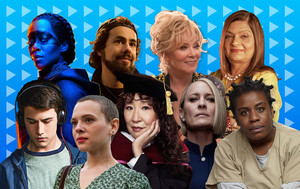Last November, Benjamin Schwartz ’03CC, ’08PS, a cartoonist for the New Yorker, was placed on daily cartooning duty for the magazine’s website. Schwartz had established himself in the weekly print magazine with his chuckle-raising panels that, for reasons that will become clear, often take place in a doctor’s office. (Example: A middle-aged Wilford Brimley type in a sweater vest and round wireframes is seated on the examination table. The doctor: “It’s avunculitis.”)
But the daily gig was different: Schwartz had to come up with one topical cartoon a day, five days a week, for three months. “There were a lot of Donald Trump cartoons,” Schwartz said recently over coffee on Columbia’s medical campus, where he is a lecturer in the narrative-medicine program at the College of Physicians and Surgeons. Inevitably, Trump presented the quandary, Schwartz says, of a subject “so over-the-top in real life that you think, ‘What can I add to this?’”
For Schwartz, cartoons are puzzles to be solved: each one starts with an idea — an observed behavior, an overheard phrase, an image — that must be tinkered with until it comes together. “Comics are a great way to train yourself to tell stories,” says Schwartz. “One of the most efficient ways you can tell a story is by trying to communicate it in just a single panel.”
In the narrative-medicine program, Schwartz says, students are taught to listen and to become storytellers themselves. “Patients experience their illness not as this set of symptoms on a checklist. They experience it as story — and not as the story of illness but as this chapter of illness in the story of their lives. We need to listen attentively to those stories and know how to extract the parts we need, and the parts that are most important to the patient. Reassembling this information in a way that satisfies the medical perspective and the human perspective is a form of storytelling.”
For his classes, Schwartz has students do exercises that build those skills. For instance, he’ll ask them to draw, from memory, Mickey Mouse. “Everyone knows what Mickey Mouse looks like, but as you’re drawing you realize you don’t know what he looks like,” says Schwartz. “You’ve seen him over and over but you don’t remember if he’s wearing a shirt. But the real takeaway is what happens afterward: the reflection on your attention to detail. As a student, you spend so much time with textbooks memorizing facts and figures that it’s very easy to not have time to think about this other stuff that you know is important. Narrative medicine gives you that time.”
Schwartz grew up in Scarsdale, the son of Allan Schwartz ’74PS, who is chief of cardiology at CUMC. As a child, Ben Schwartz wanted to be a doctor and a cartoonist. He loved comics, especially The Amazing Spider-Man; the margins of his schoolbooks were filled with sketches of superheroes. For humor he read Mad and Cracked, and also the single-panel cartoons in the New Yorker. But for one-panel punch, nothing topped the menagerie of guffaws that was Gary Larson’s The Far Side, whose sharp, twisted silliness was unlike anything else in the funny pages. Schwartz had all the collections and calendars.
His doodling habit persisted through college. But once Schwartz started medical school, he had no time for cartoons. As he went through his internship and residency, he learned, among many interesting things, that his real passion lay with his pencils. “I’d always wanted to be a cartoonist, and needed to just go full blast on that,” he says. (One imagines a single-panel cartoon, perhaps involving a window ledge, in which a young doctor tells his parents that he’s quitting medicine to draw funnies. But in fact, says Schwartz, “People were more surprised when I became a doctor.”)
In 2009, while getting by with freelance illustration jobs, Schwartz submitted some cartoons to the New Yorker and got a face-to-face meeting with the cartoon editor, Bob Mankoff, which he calls “a tremendous opportunity for any aspiring cartoonist.” Six months later, Schwartz sold his first cartoon to the magazine.
Occasionally, the magazine will reject a caption but buy the illustration, and those are the cartoons that end up on the magazine’s back page for its popular caption contest. “It’s fun to see the caption-contest results,” Schwartz says. “Every once in a while a reader will hit the exact caption you’d thought of. Or else take it in a direction you didn’t see coming.”
For daily cartooning, there’s the added pressure of heartbeat-quick deadlines. The news cycle waits for no one. “It’s amazing how fast something goes from being topical to obsolete,” Schwartz says.
Nor do all current events call for humor. Last January, Schwartz awoke to news that one of his heroes, David Bowie, had died. “Culturally, that was such an important moment, you want to say something,” Schwartz recalls.
Schwartz’s cartoon that day shows an astronaut standing on the surface of a planet, looking up at the night sky. In the blackness shines a constellation in the shape of a lightning bolt, Bowie’s symbol. The caption is a line from Bowie’s song “Space Oddity,” about an astronaut floating into oblivion: “The stars look very different today.”
The cartoon went viral, and not in the medical sense.



